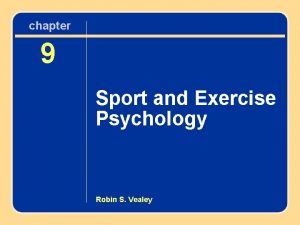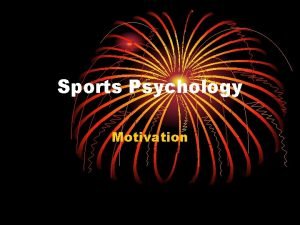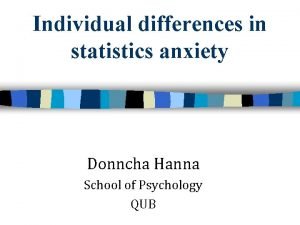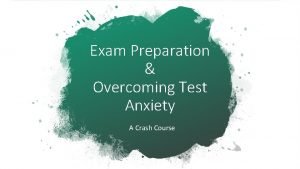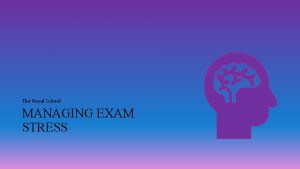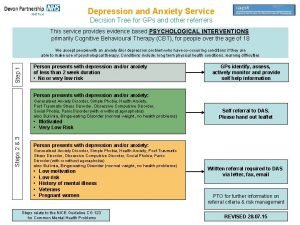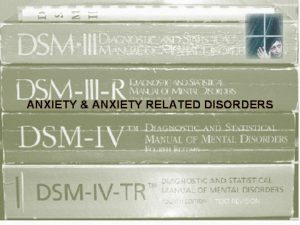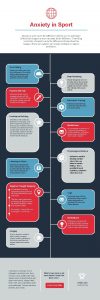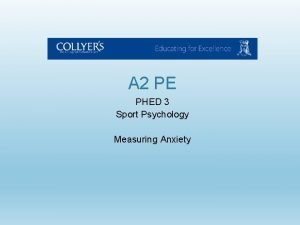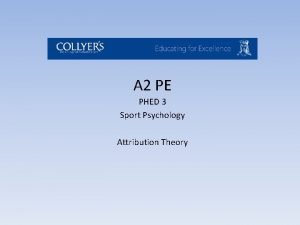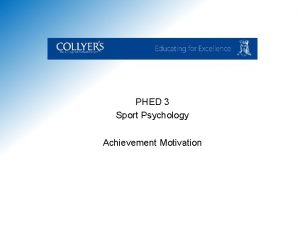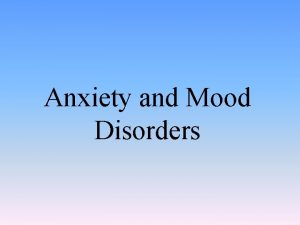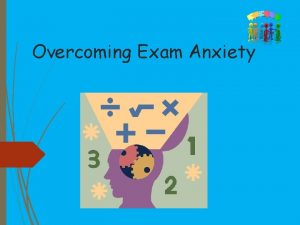A 2 PE PHED 3 Sport Psychology Anxiety

























- Slides: 25

A 2 PE PHED 3 Sport Psychology Anxiety in Sport

Anxiety in Sport

What do you need to know? • Different types of anxiety - somatic; cognitive, trait and state • Measuring anxiety – observations; questionnaires; SCAT, STA 1, CSAI 2, physiological measures • Cognitive techniques - imagery, mental rehearsal and stress management, attentional control and cue utilisation, thought stopping, self-talk • Somatic techniques – biofeedback, centring, breathing control and muscle relaxation • Goal-setting – characteristics of effective goal setting.

Anxiety in Sport • Why do Sportsman Choke?

Stress in Sport ‘The non-specific response of the body to any demand made on it‘ (Seyle 1956)

Types of Stress Eustress • These feelings sure make us feel good and they are the so-called "good stress" or "positive stress". They are able to exert a healthy effect on you. It gives one a feeling of fulfilment or contentment and also makes one excited about life. Unfortunately, it is a type of stress that only occurs for a short period of time. • Eustress is also often called the curative stress because it gives a person the ability to generate the best performance or maximum output.

Types of Stress Distress • Just like everything in life, when there are good or positive stress, there also "bad" or "negative stress". These types of stress is the opposite of Eustress and it's called Distress • Distress is a “negative stress”. It is a stress disorder that is caused by adverse events and it often influences a person’s ability to cope. Distress can be classified further as acute stress or chronic stress. Acute stress is short-lived while chronic stress is usually prolonged in nature.


Types of Stress Hyperstress • When a person is pushed beyond what he or she can handle, they will experience what we called hyperstress. • Hyperstress results from being overloaded or overworked. It’s like being stressed out. When someone is hyperstressed, even little things can trigger a strong emotional response.

Types of Stress Hypostress • Hypostress stands in direct opposite to hyperstress. That is because hypostress is one of those types of stress experienced by a person who is constantly bored. • The effect of hypostress is feelings of restlessness and a lack of inspiration.



Stress in Sport • Stressors - This is the situation that causes the stressful response. For example, competition; frustration; injury; conflict • Stress response - This is the way in which we cope with stress. Seyle developed a model called the General Adaptation Syndrome to explain this: Alarm Reaction • ‘Fight or flight’ causing an adrenaline rush, rise in heart rate and increase in blood sugar level, ready for activity. This occurs in the Autonomic Nervous System (ANS) Resistance • The body adapts to manage the stressful situation until it is overcome or passes aiming to reach a state of Homeostasis (constant physiological state) Exhaustion • The body can only cope with this state for a certain period (may be very short-term, or may be months or years, dependant on situation). If the stressful situation is not rectified the body begins to fail to cope

Anxiety 'A negative reaction of a performer to stress, often leading to over arousal‘ 'An emotional state, similar to fear, associated with arousal and accompanied by feelings of nervousness and apprehension'

Anxiety State anxiety • The athletes emotional state at any given time variable from situation to situation Trait anxiety • An athletes disposition to interpreting a situation as threatening and responding with an increase in state anxiety • Athletes who have a high trait anxiety view more situations as more threatening than those with lower trait anxiety and so respond with a higher state anxiety. This is known as competitive trait anxiety.

Measuring Stress Measuring an athletes levels of stress can be achieved in three ways: • Self-report questionnaires: Easy to complete although can be open to inaccurate responses. Examples are Martens Sports Competition Anxiety Test (SCAT) and Speilbergers State Trait Anxiety Inventory (STAI) • Physiological Measurements: Measuring physiological responses to a situation can indicate a stress response. Measurements such as heart rate, sweating, muscle tension and oxygen uptake can be used although this can involve expensive, bulky equipment • Observation: Viewing an athletes behaviour before, during and after an event can provide much information about their stress response. Clues to watch out for include shaking, talking fast, regular toilet visits, biting the nails and an inability to stay still.

Stress management

Example 1 • As Rocky’s sport psychologist, how do you propose to help him overcome his anxiety for the fight tomorrow? • Here’s what Rocky did…

Rocky • Rocky overcame his ‘perceived imbalance between ability and task demands’ (anxiety) by changing his goals. • He focused on a performance goal rather than an outcome goal (more on this next week) • He also kept things in perspective (he was always a nobody).

Example 2 • A golfer has been having problems with his swing. • How would you help him to prepare and what would you teach him to do as he has a long putt to win a competition?

Tiger Woods

What did he do?

Stress Management • Rituals and Superstition Physical Relaxation • Progressive Muscle Relaxation: This involves the deliberate contraction of muscles followed by a greater relaxation • Self-Directed Relaxation: Relies on the athletes ability to isolate and relax individual muscle groups. This can be improved through practice • Deep Breathing: This has calming effects on the mind as well as physiological effects such as reducing heart rate • Biofeedback: Observing physiological measurements such as heart rate and breathing rate allow the athlete to focus their attention on reducing these measures

Stress Management Imagery is the use of mental images and scenarios to help relax the mind. This can be either internal (seeing your performance from within your body) or external (viewing your performance as if you are someone or somewhere else). Imagery can be used to relax by picturing a favorite place or calming scene or to rehearse the upcoming performance. Mental rehearsal is thought to be effective on three levels: • Neuromuscular: Thinking through a movement produces the correct order and force of muscular contraction, much like a dryrun • Cognitive: Thinking through and planning an event in the mind can help the athlete to deal with scenarios as they arise • Confidence building: The certainty in the athletes mind of what they are going to do during the event, game plans etc can help reduce anxiety and increase motivation

Stress Management Goal Setting Goal setting is a highly useful and worthwhile technique. Having set goals helps the athlete to: • Direct their attention to the task in hand • Structure training to meet goals • Increase their confidence once goals are achieved • Evaluate their performance and progress However, the goals must meet the following guidelines in order to be effective: • They must be challenging enough, without being out of reach. The general rule is to set the goal just beyond the previous performance level • There must be a long-term, end goal. These can be reached with short and intermediate goals • Goals and achievements must be measurable. The skill/task must be measured when the goal is set and then continually re-measured so the athlete knows when the goal has been achieved • Goals must suit both the athlete and the coach in order to get the best out of both individuals
 Phed phed rosebery
Phed phed rosebery Educational sport psychology specialists
Educational sport psychology specialists Sport psychology history
Sport psychology history Exercise psychology definition
Exercise psychology definition Motivation definition by psychologists
Motivation definition by psychologists Tetrafol plus for anxiety
Tetrafol plus for anxiety Anxiety meaning
Anxiety meaning Anxiety hypothesis examples
Anxiety hypothesis examples Mr fisc anxiety
Mr fisc anxiety B lynch suture
B lynch suture Anxiety disorders def
Anxiety disorders def Auditory learner
Auditory learner Powerlessness nursing diagnosis
Powerlessness nursing diagnosis Anxiety symptoms
Anxiety symptoms Dar charting examples
Dar charting examples University of wisconsin integrative medicine anxiety
University of wisconsin integrative medicine anxiety Anxiety lan chhuah dan
Anxiety lan chhuah dan Anxiety explanation
Anxiety explanation Anxiety explanation
Anxiety explanation Amy drahota
Amy drahota Caregiver anxiety
Caregiver anxiety I'm a perfect example of someone who has math anxiety
I'm a perfect example of someone who has math anxiety Ocd symptoms in adults
Ocd symptoms in adults Anxiety attack
Anxiety attack Generalized anxiety disorder dsm 5
Generalized anxiety disorder dsm 5 Anxiety decision tree
Anxiety decision tree



